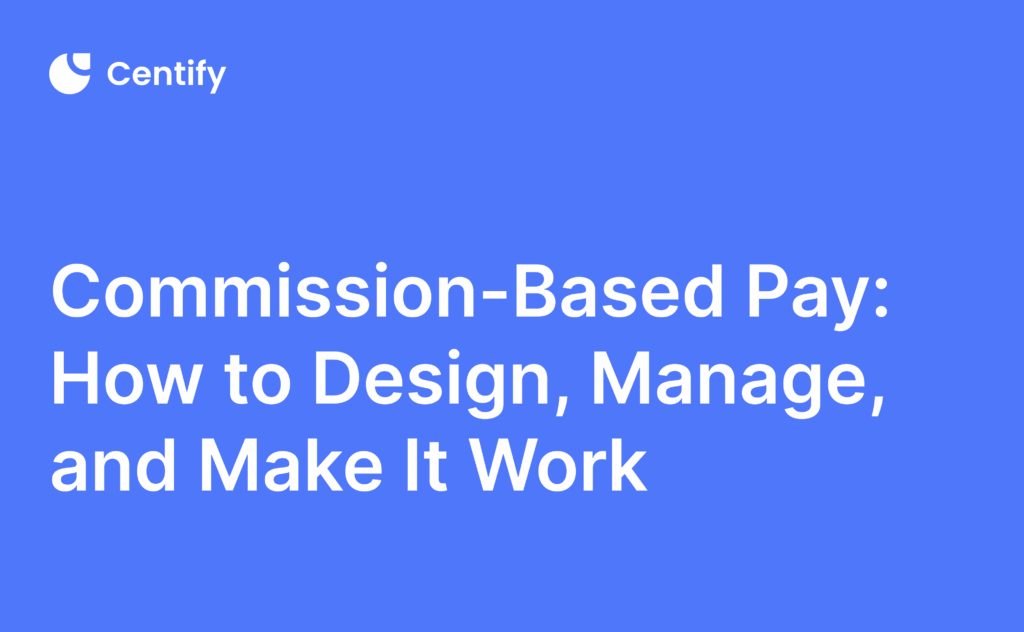Commission-Based Pay: How to Design, Manage, and Make It Work

In sales, money talks. For most salespeople, commission isn’t just a nice extra; it’s a central part of their income. The right commission structure can motivate performance, help retain high performers, and drive business growth. The wrong one can cause turnover and disputes.
Designing a commission plan means more than picking a percentage. You have to choose the right pay mix, match it to your team’s roles, keep it compliant with labor laws, and manage fluctuating paychecks without drowning in complexity. Let’s break down how to approach it.
What Commission-Based Pay Really Means
Commission-based pay is when a salesperson earns part of their income from the sales they generate. It can be their entire paycheck or sit on top of a base salary. Either way, it is designed to encourage sales activity and reward results.
The split between fixed salary and commission, often called the “pay mix,” varies. A company hiring experienced, high-energy sellers might lean toward a smaller base and larger commission opportunity, while account managers who focus on retention may get the opposite.
Commission vs. Bonus
Although both are performance-related, commission is tied directly to revenue or sales value, while a bonus is awarded for meeting specific goals. For example, a rep could be on 2% commission and still get a one-time $500 payout for hitting a short-term account target.
How It’s Calculated
Most commission is a percentage of revenue. Some companies keep it simple, others link it to gross margin or introduce tiers that increase payout rates after certain thresholds. The choice depends on your goals, whether that is driving high sales volume, focusing on profitability, or encouraging upselling.
Why Commission Can Reduce Turnover
When pay is tied to results, high performers can directly influence their income. That is a powerful motivator, especially in competitive markets. Without attractive commission potential, skilled sellers may be tempted to jump ship for better offers. Replacing them can cost more than paying them well in the first place.
Common Commission Structures
Sales organizations often use one of these models:
- Straight commission: Earnings come entirely from sales, no base pay. High risk, high reward.
- Base plus commission: A stable salary combined with extra for hitting targets.
- Gross-margin commission: Rewards profitability over raw sales value.
- Tiered commission: Higher rates as reps approach or exceed quota.
- Variable commission: Different rates for specific products, services, or regions.
- Residual commission: Ongoing payments for customer renewals or subscriptions.
- Multiplier commission: Higher rates when reps hit secondary goals like upselling.
- Territory or team-based commission: Shared earnings based on collective results.
Each has trade-offs, so the right fit depends on your business model, sales cycle, and market.
Choosing the Right Approach
When building your plan, consider:
- Business priorities: Align commission with what you want to achieve, whether that is new customer growth, margin improvement, or retention.
- Sales cycle length: Shorter cycles may favor immediate payouts; longer ones might require staged commission to keep motivation steady.
- Territory conditions: Even distribution of opportunity matters. Adjust rates if some territories are harder to sell into.
- Industry norms: Rates vary widely by sector.
- Team preferences: Risk-tolerant reps might prefer high variable pay; others value stability.
Legal and Compliance Essentials
In most countries, commission plans must meet minimum wage requirements, handle overtime correctly, deduct taxes properly, and ensure equal pay for comparable roles. If you operate in multiple states or countries, rules can differ, so legal review is essential.
A written sales commission agreement protects both the business and the rep. It should outline payout rates, how earnings are calculated, timelines for payment, dispute resolution processes, and any clawback provisions.
Best Practices for Managing Commission Plans
- Use targeted incentives wisely: Short-term bonuses can drive focus on specific products or goals, but changing them too often creates confusion.
- Include clawbacks where necessary: This allows you to reclaim commission if a sale falls through or was made in bad faith.
- Avoid hard caps: Unlimited earning potential keeps reps motivated; after all, you only pay when the business makes money.
- Stay transparent: Explain how commission is calculated and why it might differ by territory or role to avoid resentment.
Leveraging Technology
Commission administration can get messy, especially when payouts fluctuate. Incentive management software can centralize data, automate calculations, forecast plan changes, and give reps real-time dashboards. This helps them track progress toward on-target earnings and keeps payroll accurate without manual number-crunching.
The Takeaway
A well-crafted commission plan is more than a paycheck; it is a strategic lever for growth. When it is aligned with company goals, legally sound, and easy to manage, it keeps top sellers motivated and loyal while ensuring the business only pays for actual performance. The real win is finding a balance that rewards both the rep and the organization.